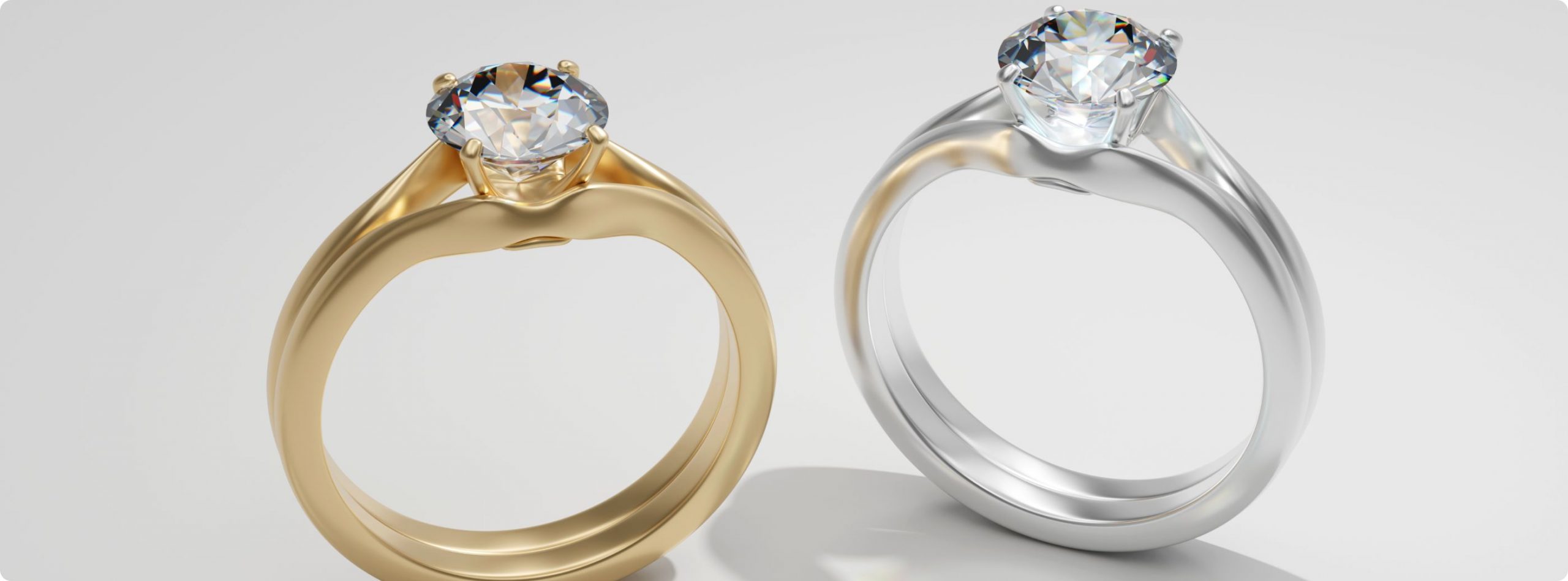The Difference Between White Gold And Platinum

5min read

When it comes to choosing the perfect metal for your jewellery, two popular options that often leave people perplexed are white gold and platinum. Both these metals exude a brilliant white luster, making them highly desirable for engagement rings, wedding bands, and other exquisite pieces. However, despite their apparent similarities, there are essential distinctions that every jewellery enthusiast should understand before making a decision.
In this blog, we will delve into the unique characteristics of white gold and platinum to help you make an informed choice for your precious jewellery.
Composition and Purity
One of the primary differences between white gold and platinum lies in their composition. White gold is an alloy made by combining pure gold with white metals such as silver, palladium, or nickel. The caratage of gold determines its purity, with 24-karat gold being 100% pure gold. Commonly used caratages for white gold are 18k and 14k, indicating that they contain 75% and 58.5% pure gold, respectively. The remaining percentage is made up of the other metals in the alloy, which impart the white color to the gold.
On the other hand, platinum is a naturally white metal, making it significantly different from white gold. When used in jewellery, platinum is usually 95% to 98% pure. Its purity level is indicated by the hallmark “950 Plat” or “950 Pt,” signifying that the metal contains 95% pure platinum.
Durability and Hardness
In terms of durability and hardness, platinum is the clear winner. Platinum is renowned for its exceptional strength and resistance to wear, making it an ideal choice for everyday jewellery. Its density and weight also add to its robustness, ensuring that your precious pieces will stand the test of time.
White gold, however, is slightly less durable than platinum due to its alloy composition. Depending on the metals used in the alloy, white gold can be more susceptible to scratches and signs of wear over time. However, this doesn’t mean white gold is not suitable for jewellery; it merely requires more care and maintenance to retain its brilliance.
Color and Appearance
Both white gold and platinum offer a stunning white appearance, but they do have distinct differences in color. White gold typically has a slightly warmer hue due to the presence of yellow gold in the alloy. To enhance the whiteness, white gold jewellery is often rhodium-plated, giving it a bright, mirror-like finish. Keep in mind that rhodium plating will wear off over time, and the jewellery may require re-plating periodically to maintain its luster.
On the other hand, platinum’s natural white color is cooler and more elegant without the need for rhodium plating. It possesses a timeless, silvery-white appearance that remains unchanged throughout the years.
Weight and Density
Platinum’s density is higher than that of white gold, making platinum jewellery noticeably heavier. Some individuals prefer the substantial feel of platinum, as it adds to the sense of luxury and value. However, others may find it too weighty for their liking, particularly if they prefer lightweight jewellery.
White gold, being less dense, offers a lighter feel, making it a preferred choice for those who enjoy the comfort of a lighter piece.
Hypoallergenic Properties
Another essential factor to consider, especially for individuals with sensitive skin, is the hypoallergenic properties of the metals. Platinum is naturally hypoallergenic and an excellent choice for those prone to metal allergies. Its purity and lack of additional alloys minimize the risk of skin irritations, making it a safe and comfortable option.
While white gold itself is not hypoallergenic, it can be alloyed with metals that are less likely to cause allergies, such as palladium or platinum. However, nickel is a common allergen used in some white gold alloys, so individuals with nickel allergies should exercise caution and opt for nickel-free white gold alloys.
Cost and Affordability
Cost is often a crucial consideration when choosing between white gold and platinum. Platinum’s rarity and higher purity make it more expensive than white gold. The intricate process involved in mining and refining platinum contributes to its elevated price tag. White gold, being a gold alloy, is generally more affordable, making it an attractive option for those seeking a budget-friendly yet elegant choice.
Versatility and Style
Both white gold and platinum offer incredible versatility in design. Their neutral white appearance complements a wide range of gemstones, making them suitable for various jewellery styles. Whether you prefer a classic, vintage, or contemporary design, both metals can be crafted into exquisite masterpieces that reflect your personal style.
In conclusion, the choice between white gold and platinum ultimately depends on your personal preferences, lifestyle, and budget. Platinum boasts unrivaled durability and naturally white color, while white gold offers affordability and a warm, classic look. Regardless of your decision, both metals guarantee timeless beauty and elegance, making your jewellery a cherished possession for generations to come.
Remember to consider the factors that matter most to you, and consult with a reputable jeweller to find the perfect metal that perfectly complements your style and sensibilities.







